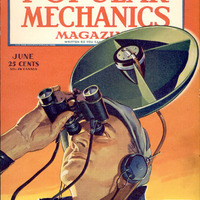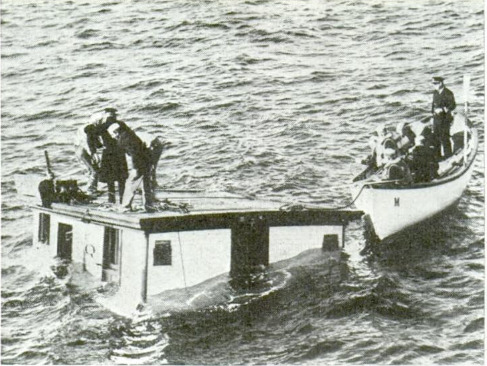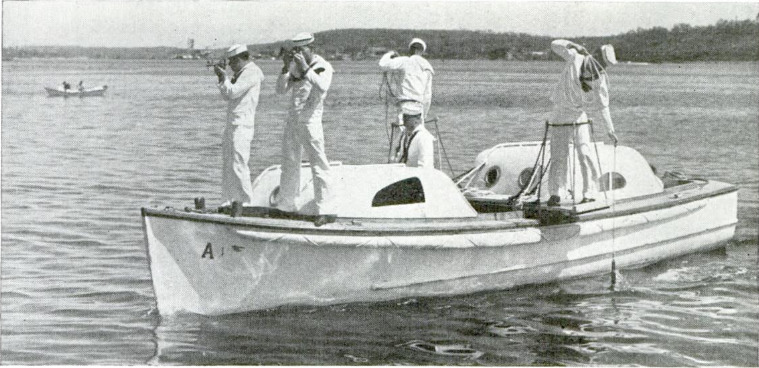THEY’RE lifesavers in peace, but the Coast Guard has never missed a fight. They're in the Navy now, as they were in other wars. Back in 1812 they stood with the young American Navy against the British. They wrote exciting chapters in the Seminole uprisings of 1836, the Mexican War of 48 and the Spanish-American war in '98. In the first world war they performed valiant and dangerous service, maintaining the shore defenses of the United States, helping track and destroy submarines, convoying ships between Gibraltar and England. The percentage of men lost was the highest of any branch of Uncle Sam’s forces, including even the army. The Coast Guard began polishing up its famous motto, “Semper Paratus” - always ready - as long ago as 1934, when Hitler made his first open aggressive move by marching troops into the Rhineland. Last November 2, a month before actual war, President Roosevelt put the entire Coast Guard under Navy jurisdiction; but even before that Coast Guard ships and planes had been on “active” service. It was the Coast Guard Cutter “Bear,” that reconditioned veteran that had served Admiral Byrd in the Antarctic, that apprehended off Greenland a Norwegian vessel that was acting as offshore base for a German radio station. Although smaller than the Army or Navy in man power and equipment, the Coast Guard is the sentinel of the American coast- line, the United States’ seagoing police. Since its founding in 1790 under George Washington, the Coast Guard has performed a wide variety of duties. These have in-cluded the prevention of smuggling of liquor, narcotics and other contraband; patrol of the waters of the North Atlantic and the North Pacific; enforcement of navigation laws; protection of furbearing animals, birds and fishing grounds; supervision of the anchorage and movement of vessels handling dangerous cargoes; winter patrol of the ocean to help people or vessels in distress; removal of derelicts and other obstructions to navigation; maintenance of a system of marine aids to navigation including lighthouses, lightships, radio beacons and buoys. So essential to the walfare of the nation has the Coast Guard become that it is now more than five times as large as it was in 1917. Before Pearl Harbor it comprised 800 commissioned officers, 450 warrant officers, 19,000 men and 5,000 civilian personnel. War has brought many new duties to the Coast Guard which it must carry on in addition to its peace-time chores. The Coast Guard's hundreds of seagoing cutters have been converted for war duties under specifications provided by the Navy Department. The conversion work includes the installation of additional guns, enlargement of magazines, fitting of depthcharge racks and the installation of ordnance and underwater sound detection apparatus. In addition to readying-up its present equipment, the Coast Guard has been authorized to obtain new ships - just how many is a military secret. Shipbuilding ways and a $500,000 dry dock are being built to provide new cutters for the Coast Guard. Since aviation has come to be an essential part of the Coast Guard, it was only natural that “the Service” should be called to help the Navy in patrolling the blue waters, spotting from the air and reporting the presence of enemy submarines and raiders. The Coast Guard is especially proud of its record in the air. In addition to many dramatic and spectacular flights to deliver serum or remove sick persons from ships at sea, it was patrolling the ocean long before the Neutrality Patrol came into being The Coast Guard likes to remember that one of its own officers, Commander E. F. Stone was co-pilot of the first flying boat to cross the Atlantic, the NC-4. With America’s shipbuilding yards humming night and day, and dozens of military and merchant craft sliding down the ways each month, the Coast Guard’s duties of keeping harbors, coastlines and rivers safe for shipping take on a vast military importance. In 1939 the control of 30,000 navigational aids in America’s rivers and harbors was transferred from the department of Commerce to the Coast Guard. In the last twelve months these have been increased by more than 1,000. Navigational aids include some 500 fully attended lighthouses on the Atlantic and Pacific coasts, Puerto Rico, Alaska and Hawaii; several thousands of other helps to safe shipping; 31 lightships on both coasts; 20,000 buoys in navigable waters. All this has meant additional work for the stout-hearted men of the Coast Guard. President Roosevelt’s proclamation of June 27, 1940, gave the Coast Guard the job of supervising the unloading of explosives and other dangerous cargoes in American ports - as well as the anchorage and movement of all such vessels. The Coast Guard’s long experience in maintaining the International Ice Patrol in the Atlantic and the Bering Sea Patrol in the North Pacific waters around Alaska is now increasingly important with both these areas essential to the sea defenses of the United States. Coast Guard Cutters have acted as stations in the mid-Atlantic serving as weather observation posts. Weather observations in Nine-lens camera mid-Atlantic are particularly important at the present time - if Clipper plane crossings of the Atlantic are to be continued. The war has halted nearly all of the voluntary meteorological reporting which used to be performed by commercial vessels and upon which the U. S. Weather Bureau relied. Information from Europe, too, has been seriously curtailed. Weather reports ordinarily are flashed to the U. S. Weather Bureau from the mid-Atlantic Coast Guard cutters at 6-hour intervals, day and night. This information is based upon observations made every three hours, upon pilot balloon observations of the upper air made every six hours and upon other observations taken hourly. In peace time, radiosonde observations were taken each morning at 3 am. in the upper air at heights of 50,000 feet. The radiosonde, a miniature radio broadcasting station weighing less than 2 pounds, is sent aloft attached to a carrier balloon. Observations of the temperature, air pressure and humidity are broadcast continuously by the radiosonde device and received aboard the cutter by a special radio receiver. The Coast Guard’s long experience in ice-breaking activities has already proved to be valuable in the national defense program. Last spring the Coast Guard opened the Sault Ste. Marie locks on the Great Lakes on April 13 - the earliest navigation through the locks in 40 years. This record-breaking opening of ice-choked channels after a severe winter made possible the passage of ships from ore ports on Lake Superior to lower lake ports such as Chicago, Detroit and Cleveland. Last year, for the first time, the Coast Guard sent one of its Grumman JRF-3 planes and a communications truck to the Great Lakes area. Each day reconnaissance flights were made to obtain information on the position, movement and thickness of the ice. This information, co-ordinated with reports from shore stations, proved valuable in sending ice-breaking ships to the proper places at the proper time. The Coast Guard played an important role in putting into practical use the marine radio beacon - said to be the most important development in lighthouse engineering in recent years. Radio beacon signals were broadcast from 144 lightships and lighthouses along the Pacific, the Atlantic and the Great Lakes. They are especially valuable to navigation because they are audible night or day, in clear weather or in fog. They have a maximum range of up to 200 miles. A simple dot and dash signal, broadcast on a definite time schedule, serves to identify the sending station. Then by means of a radio direction finder the listening ship determines the direction from which the signal comes. As radio beacons are audible far beyond the visibility of the most powerful lights, a comparatively small number of stations can effectively mark the navigable waters of the United States. To carry on its war duties, in addition to its many regular jobs of peace time, the Coast Guard is increasing its personnel. The Coast Guard Reserve, set up by Congress on February 19, 1941, created a reserve force of several hundred officers and enlisted men - all of whom are now on active duty. This organization is comparable to the United States Naval Reserve whose officers and men are called to active duty during a national emergency and who return to civilian life when hostilities are at an end. Taking a page from the experience of the British at Dunkirk who found that amateur yachts-men, fishermen and other small craft operators performed gallantly, the Coast Guard has organized the Coast Guard Auxiliary. This is a volunteer organization which operates its privately owned boats to patrol the harbor and coastline. Already there are thousands of volunteers and small boats in this organization. The Coast Guard's role in America's defense was foreseen some time ago and steps were taken to provide a larger number of trained officers. At its own Academy, the “Annapolis” of the Coast Guard, a new library, barracks, infirmary, ordnance building, boathouse and wharves are being built. The Coast Guard cadets undergo a four-year course of mathematics, seamanship, navigation, communications, history, foreign languages, etc. Upon graduation the young officers are commissioned as ensigns with the same pay and opportunities of promotion as in the U.S. Navy. The Coast Gard has cheerfully shouldered another job in taking over the training of merchant seamen for the U. S. Maritime Commissiorl. At training stations on both the Pacific and the Atlantic coasts, men without previous sea experience are whipped into shape to serve with America’s fast-growing merchant marine. It is planned to train 1,000 licensed officers and 6,000 men under this program.
 Popular Mechanics, vol. 77, n. 6, 1942
Popular Mechanics, vol. 77, n. 6, 1942





